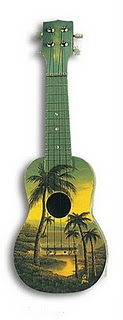The Desire For Excellence
 Jerry Byrd
(1920-2005) was one of the greatest steel guitar players in history. At age
68 Jerry Byrd made the following video,
thanking the Lord for everything he had. Then Jerry plays the Kalima
Waltz, which is just like the original album. Just listen to Song of the
Islands on his Pagan Paradise album and you'll see what I mean.
No one has ever played harmonics like that. Here is some helpful
information...
Jerry Byrd
(1920-2005) was one of the greatest steel guitar players in history. At age
68 Jerry Byrd made the following video,
thanking the Lord for everything he had. Then Jerry plays the Kalima
Waltz, which is just like the original album. Just listen to Song of the
Islands on his Pagan Paradise album and you'll see what I mean.
No one has ever played harmonics like that. Here is some helpful
information...
Jerry Byrd was a perfectionist. Everything had to be just right or it wasn't good enough. That's why his music is so exceptional. Each of his thousands of performances was the best he could do.
Jerry was not satisfied to merely have a guitar. He wanted the complete package in order to develop "the sound" that was so clear in his mind.
He long recommended a plastic thumb pick and two (2) medium (.018) gage Dunlop metal finger picks for creating "his sound".
Jerry's preferred stainless steel bar was a Dunlop 3/4" by 2 3/4", bullet nose with a recessed butt-end that enabled him to make those rapid bar slants with ease.
Not satisfied with store-bought packaged strings, Jerry experimented until he found the perfect combination of strings that was able to produce "his sound".
In the early days, Jerry used Spanish Guitar strings distributed by the Gibson Guitar Co. For strings #1, #2 and #3, he used plain, second guitar strings and used a plain 3rd string for his fourth string position. This enabled him to play seamless melody lines without the slightest hint of "string noise" during his many forward and reverse bar slant positions.
Jerry used flat wound strings for the remaining string requirements.
Fortunately, Jerry shared his thoughts about the steel guitar. Thankfully Jerry left the world his music (hundreds of recordings). Many excellent musicians never record their music and it dies with them. How sad! The best way to learn Hawaiian steel guitar is to listen to other steel players. There are many great steel guitar players today, but I'll always like Jerry's style. Look at Jerry's online videos. Get his instructional videos and books while they're still available.
I met Jerry Byrd in 1993 in Winchester, Indiana but didn't realize how special he was at the time, although he wouldn't have thought so. Jerry was a humble person. Jerry Byrd is a legend on steel guitar. I think Jerry said it best... All the talent in the world means nothing if you don't have desire. I've had people say to me, "I wish I had your talent"; but they could if they'd turn off the television and prioritize their time. We all have 24 hours in a day. Most people sit idle in front of the TV wasting their time, or gossiping to tear down others. Music is a positive, constructive, and uplifting pursuit.
“I've often wondered how the term 'playing' ever came to be so universally synonymous with music, But then again, what would we replace it with? I suppose it is a form of play, but it can also be work. Now we are talking about how music is being done; seriously or playfully. As for myself, I'm working.” —Jerry Byrd, “It Was A Trip On Wings Of Music,” by Jerry Byrd (1920-2005); © 2003, p. 109.
Most people fail at everything they try in life, because they quit. Attitude is everything. I do not claim to be a great musician, but I understand enough of what Jerry Byrd (who was arguably the greatest Hawaiian steel guitarist ever) was teaching to see what he meant. Jerry taught that excellence doesn't come easy. There are no short cuts, no gimmicks, no easy roads to success. You have to work at it. The most important thing is consistency, which goes back to desire. How bad do you want something? You don't have to play 12 hours a day to get good, just 30 minutes a day would be great. Turn off the TV and you'd be surprised what you can accomplish. The more time you put into it, the faster you'll learn it. It's as simple as that.
“The difference between an artist and a musician is the difference between self-expression and either playing off of paper or by note. An artist creates and others follow. When you hear someone play two choruses exactly the same, he or she is playing from memory and hasn't a clue as to the chord progressions involved. It is impossible to improvise unless you know or can recognize immediately every chord being used.” —Jerry Byrd, “It Was A Trip On Wings Of Music,” by Jerry Byrd (1920-2005); © 2003, p. 109.
Also, your brain processes the things you've learned when you're NOT playing. So give yourself a break. It's actually better not to practice too much at once. You'll get a little better each time you return to your instrument. Of course, there's going to be days when you think all hope is gone and you'll never learn the instrument. That happens to everyone at first. The best motivation to learn any instrument is to keep listening to more steel guitar. Listen to your favorite performers and analyze their playing. Try to learn from their records. Become particular about little things; such as, vibrato, bar movement, being precise in what you are playing, not too much effects. Hear what you play and play what you hear.
“I thank the Lord every night I go to bed, for what I've had. I'm 68 this year. And I still got all my faculties. I, at least, can remember a few things if I want to. Most of them I don't want to (laughter).” —Jerry Byrd at a 1993 Hawaiian Steel Guitar Convention | Part 2.
Jerry Byrd defined excellence on the steel guitar, raising the bar high for us all, and setting a standard for generations to come. Jerry teaches...
“Music as an art form is not expressed mechanically. The artist must communicate his emotions to those of his or her listeners, and they don't need to know what instrument you are playing - many of them wouldn't know what a steel guitar is - or even what song you're playing. The listener only needs to get your message. You can send that message with music - plain, beautiful music. Sooner or later you will realize that razzle-dazzle technique and a big toothpaste-selling smile mean nothing. An audience will remember you for what you said to them musically.. I stress these points in my teaching. Music is a form of psychology, and just making sounds won't cut it.. If you don't feel it, how can your listeners feel it?” —Jerry Byrd, “It Was A Trip On Wings Of Music,” by Jerry Byrd (1920-2005); © 2003, p. 112.
 Jerry
Byrd loved his Fender TWIN REVERB. It has a dark, muddy sound that is
great for lap steel. But it's terrible for pedal steel. The Hot Rod
Deville 2-12 or 4-10 is awesome for pedal steel, because there's a
button you press that boosts your highs. It is fantastic! I like my lap
steel on the dark side, not too bright. Rickenbachers are great at about 2-4
on the tone knob.
Jerry
Byrd loved his Fender TWIN REVERB. It has a dark, muddy sound that is
great for lap steel. But it's terrible for pedal steel. The Hot Rod
Deville 2-12 or 4-10 is awesome for pedal steel, because there's a
button you press that boosts your highs. It is fantastic! I like my lap
steel on the dark side, not too bright. Rickenbachers are great at about 2-4
on the tone knob.
Here are some more interesting quotes from Jerry Byrd...
Thanks to Jerry's brother Jack Byrd, I've received the following comments from Jerry Byrd, some things he felt all aspiring steel guitar players should want to make note of.
When Jerry started recording (his first solo in 1949), "it was a time before there was reverb - we had no reverb, no tracking - no digital - no nothing. They stuck a microphone in your amplifier speaker, leaned it over the back of a chair up into your amp and you played the sound that was in the guitar and that was it."
"Couldn't change anything and it went on the recording medium the same way - before they even had tape - so whatever went on there was what came out of the amplifier speaker - no doctoring like they can do now."
"On the mix down now they can change everything, pitch, tone, everything but back then, you took what came through that speaker and that was it".
"So, I think Skip is going to have to explain all that - that all you're going to hear is pure unadulterated playing, nothing could be jazzed or doctored up or altered in anyway. When the light went on you had to play until it went off. Somebody messes up, you have to go back and start at the beginning. Now, they can splice in, they can put in two or one note, take out two or one note, do all kinds of things, change pitch, change the tone."
"We had to play it from the beginning to the end back then and we had to do four songs in three hours. These were new songs, none of us ever heard before, that's why they recorded them. They were new good songs at the time."
"So you had to create something of your own, but they will never understand that probably. You can explain it, but they will never understand the difficulty factor it was. Many of the songs Ray will put on there, I will have no recall of, at all".
"I don't remember three fourths of the recordings I did, they are a blur. Many people don't realize I was trying to make a living then. I got $41.25 for each session, three hours work per session, and if they sold a million, we got nothing. So, a lot of the records Skip will be putting up, are beyond my recall."
SOURCE: Jerry Byrd - http://www.jerrybyrd-fanclub.com/
~By David J. Stewart
Below: Waikiki Beach in Oahu, Hawaii
Above: Rogue Lap Steel with Aluminum Nut. There's a coconut palm tree painted on my neck. I took a photo of the guitar and then used an effect in my Microsoft Photo Editor program called "Edge" to give it a drawing look. Pretty neat!


